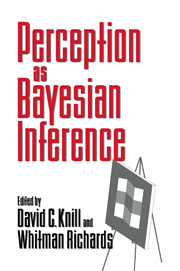Book contents
- Frontmatter
- Contents
- List of contributors
- Preface
- 0 Introduction
- Part one Bayesian frameworks
- 1 Pattern theory: A unifying perspective
- 2 Modal structure and reliable inference
- 3 Priors, preferences and categorical percepts
- 4 Bayesian decision theory and psychophysics
- 5 Observer theory, Bayes theory, and psychophysics
- Commentaries
- Part two Implications and applications
- Commentaries
- Author index
- Subject index
2 - Modal structure and reliable inference
Published online by Cambridge University Press: 05 March 2012
- Frontmatter
- Contents
- List of contributors
- Preface
- 0 Introduction
- Part one Bayesian frameworks
- 1 Pattern theory: A unifying perspective
- 2 Modal structure and reliable inference
- 3 Priors, preferences and categorical percepts
- 4 Bayesian decision theory and psychophysics
- 5 Observer theory, Bayes theory, and psychophysics
- Commentaries
- Part two Implications and applications
- Commentaries
- Author index
- Subject index
Summary
Introduction
The world we live in is a very structured place. Matter does not flit about in space and time in a completely unorganized fashion, but rather is organized by the physical forces, biological processes, social interactions, and so on which exist in our world (McMahon, 1975; Thompson, 1952). It is this structure, or regularity, which makes it possible for us to make reliable inferences about our surroundings from the signals taken in from various senses (Marr, 1982; Witkin and Tenenbaum, 1983). In other words, regularities in the world make sense data reliably informative about the world we move around in. But what is the nature of these regularities, and how can they be used for the purposes of perception?
In this chapter, we consider one class of environmental regularities which arise from what we call the modal structure of the world and which has the effect of making sensory information for certain types of perceptual judgements highly reliable (Bobick and Richards, 1986). Our definition of modal regularities is motivated by careful analyses of some simple examples of reliable perceptual inferences. Given the resulting definition, we then briefly discuss some of the implications for the knowledge required of a perceiver in order for it to make reliable inferences in the presence of such modal structure.
Modal structure: An example
When can we infer that an object is stationary?
A common perceptual inference is that of whether an object is moving or at rest. How can we make this inference given only the two-dimensional projection of a three-dimensional object?
Information
- Type
- Chapter
- Information
- Perception as Bayesian Inference , pp. 63 - 92Publisher: Cambridge University PressPrint publication year: 1996
Accessibility standard: Unknown
Why this information is here
This section outlines the accessibility features of this content - including support for screen readers, full keyboard navigation and high-contrast display options. This may not be relevant for you.Accessibility Information
- 15
- Cited by
